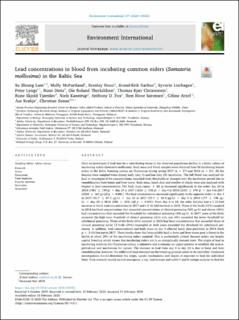| dc.contributor.author | Lam, Su Shiung | |
| dc.contributor.author | Mcpartland, Molly | |
| dc.contributor.author | Noori, Brenley | |
| dc.contributor.author | Garbus, Svend-Erik | |
| dc.contributor.author | Lierhagen, Syverin | |
| dc.contributor.author | Lyngs, Peter | |
| dc.contributor.author | Dietz, Rune | |
| dc.contributor.author | Therkildsen, Ole Roland | |
| dc.contributor.author | Christensen, Thomas Kjær | |
| dc.contributor.author | Tjørnløv, Rune Skjold | |
| dc.contributor.author | Kanstrup, Niels | |
| dc.contributor.author | Fox, Anthony D. | |
| dc.contributor.author | Sørensen, Iben Hove | |
| dc.contributor.author | Arzel, Céline | |
| dc.contributor.author | Krøkje, Åse | |
| dc.contributor.author | Sonne, Christian | |
| dc.date.accessioned | 2021-04-09T07:08:26Z | |
| dc.date.available | 2021-04-09T07:08:26Z | |
| dc.date.created | 2021-01-13T17:10:26Z | |
| dc.date.issued | 2020 | |
| dc.identifier.issn | 0160-4120 | |
| dc.identifier.uri | https://hdl.handle.net/11250/2737020 | |
| dc.description.abstract | Here we investigate if lead may be a contributing factor to the observed population decline in a Baltic colony of incubating eiders (Somateria mollissima). Body mass and blood samples were obtained from 50 incubating female eiders at the Baltic breeding colony on Christiansø during spring 2017 (n = 27) and 2018 (n = 23). All the females were sampled twice during early (day 4) and late (day 24) incubation. The full blood was analysed for lead to investigate if the concentrations exceeded toxic thresholds or changed over the incubation period due to remobilisation from bones and liver tissue. Body mass, hatch date and number of chicks were also analysed with respect to lead concentrations. The body mass (mean ± SD g) increased significantly in the order: day 24 in 2018 (1561 ± 154 g) < day 24 in 2017 (1618 ± 156 g) < day 4 in 2018 (2183 ± 140 g) < day 4 in 2017 (2359 ± 167 g) (all p < 0.001). The lead concentrations increased significantly in the opposite order i.e. day 4 in 2017 (41.7 ± 67.1 μg/L) < day 24 in 2017 (55.4 ± 66.8 μg/L) < day 4 in 2018 (177 ± 196 μg/L) < day 24 in 2018 (258 ± 243) (all p < 0.001). From day 4 to 24, the eider females had a 1.33-fold increase in blood lead concentrations in 2017 and a 1.46-fold increase in 2018. Three of the birds (13%) sampled in 2018 had lead concentrations that exceeded concentrations of clinical poisoning (500 μg/L) and eleven (48%) had concentrations that exceeded the threshold for subclinical poisoning (200 μg/L). In 2017, none of the birds exceeded the high toxic threshold of clinical poisoning while only one (4%) exceeded the lower threshold for subclinical poisoning. Three of the birds (6%) sampled in 2018 had lead concentrations that exceeded those of clinical poisoning while 12 birds (24%) resampled in both years exceeded the threshold for subclinical poisoning. In addition, lead concentrations and body mass on day 4 affected hatch date positively in 2018 (both p < 0.03) but not in 2017. These results show that bioavailable lead in bone and liver tissue pose a threat to the health of about 25% of the incubating eiders sampled. This is particularly critical because eiders are largely capital breeding which means that incubating eiders are in an energetically stressed state. The origin of lead in incubating eiders in the Christiansø colony is unknown and it remains an urgent priority to establish the source, prevalence and mechanism for uptake. The increase in lead from day 4 to day 24 is due to bone and liver remobilization; however, the additional lead source(s) on the breeding grounds needs to be identified. Continued investigations should determine the origin, uptake mechanisms and degree of exposure to lead for individual birds. Such research should include necropsies, x-ray, lead isotope and stable C and N isotope analyses to find the lead sources(s) in the course of the annual cycle and how it may affect the population dynamics of the Christiansø colony which reflects the ecology of the Baltic eiders being suitable for biomonitoring the overall flyway. | en_US |
| dc.language.iso | eng | en_US |
| dc.publisher | Elsevier | en_US |
| dc.rights | Navngivelse 4.0 Internasjonal | * |
| dc.rights.uri | http://creativecommons.org/licenses/by/4.0/deed.no | * |
| dc.title | Lead concentrations in blood from incubating common eiders (Somateria mollissima) in the Baltic Sea. | en_US |
| dc.type | Journal article | en_US |
| dc.type | Peer reviewed | en_US |
| dc.description.version | publishedVersion | en_US |
| dc.source.volume | 137 | en_US |
| dc.source.journal | Environment International | en_US |
| dc.identifier.doi | https://doi.org/10.1016/j.envint.2020.105582 | |
| dc.identifier.cristin | 1870874 | |
| cristin.ispublished | true | |
| cristin.fulltext | original | |
| cristin.qualitycode | 1 | |

